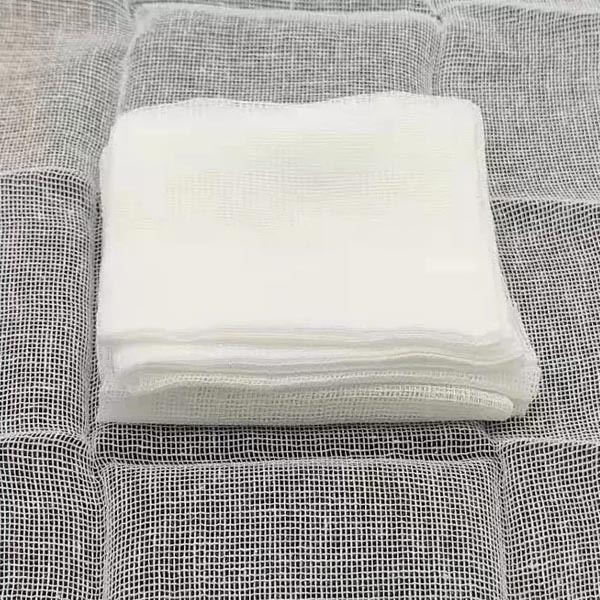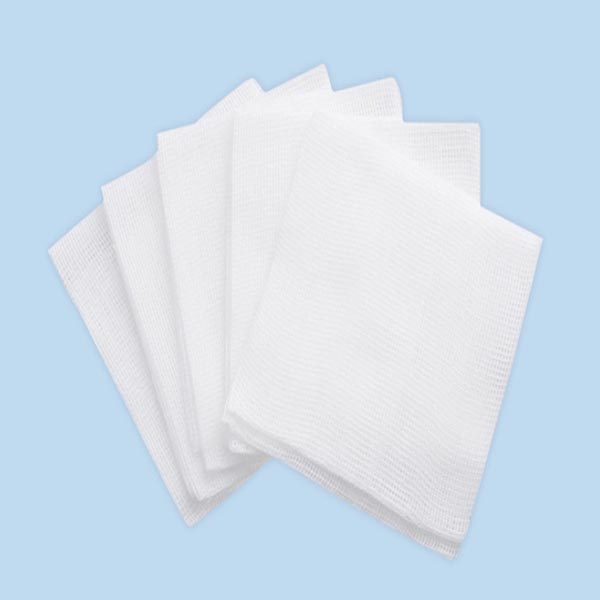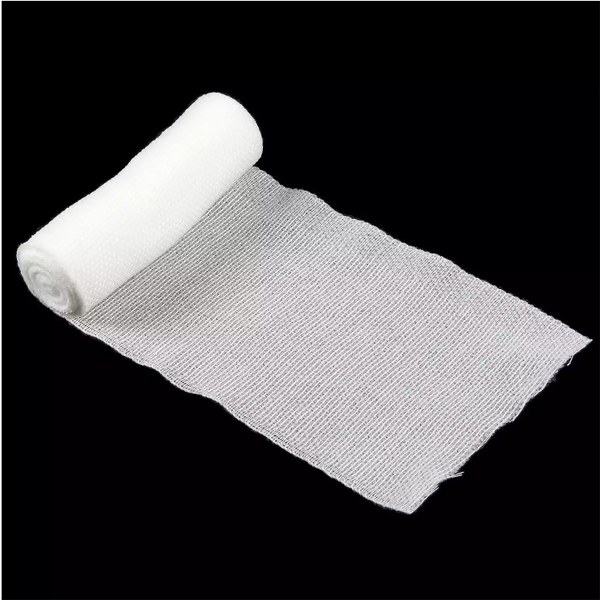This article provides a thorough overview of medical gauze, covering different types of gauze pads and gauze rolls, their uses, and how to choose the right product for specific wound care needs. It’s worth reading because understanding the nuances of medical gauze – from sterile vs. non-sterile options to the different types of gauze available – is crucial for effective wound management, whether you’re a healthcare professional or preparing a home first aid kit. This guide offers practical advice from a manufacturer’s perspective, helping you make informed decisions.
1. What is Medical Gauze and Why is it Used?
Medical gauze is a thin, woven or non-woven fabric, typically made from cotton (although synthetic fibers can also be used), designed for use in wound dressing and other medical applications. Gauze is used to protect wounds, absorb fluids (exudate), and promote healing. It’s a fundamental component of wound care in hospitals, clinics, and homes. The primary function of gauze is to provide a barrier against infection while allowing air to circulate, facilitating the natural healing process.
Gauze is made from cotton and is often used to make dressings. Gauze helps create a moist wound environment, which is ideal for cell regeneration. It is used in wound care for cleaning, packing, and covering various types of wounds. Gauze plays a crucial role in protecting newly formed tissue.
2. What are the Main Types of Medical Gauze? (Woven vs. Non-Woven)
The main types of medical gauze are woven and non-woven. Understanding the difference between gauze types is essential for choosing the right product.
- Woven Gauze: Woven gauze is made from cotton fibers interlaced in a crisscross pattern, creating a weave. This type offers good absorbency and is suitable for a wide range of applications. It’s commonly used for general wound cleaning, dressing, and packing. However, woven gauze can sometimes leave behind lint in the wound, which can interfere with healing.
- Non-Woven Gauze: Non-woven gauze is made from synthetic fibers (like rayon, polyester, or blends) that are pressed together, rather than woven. This manufacturing process results in a material that is generally more absorbent than woven gauze and produces less lint. Non-woven gauze is ideal for delicate wounds or situations where minimizing lint is critical. It’s also often softer and more comfortable for the patient.
Non-woven gauze is made from synthetic fibers and tends to produce less lint than traditional woven gauze. Both woven gauze and non-woven varieties are widely used for dressing wounds and other medical supplies.3. Gauze Pads vs. Gauze Rolls: What’s the Difference and When to Use Each?
Gauze pads and gauze rolls are two primary forms of medical gauze, each serving different purposes.
- Gauze Pads: Gauze pads are pre-cut squares or rectangles of gauze, available in various sizes and thicknesses (ply). They are ideal for small wounds, minor cuts, cuts and scrapes, and as a primary dressing applied directly to the wound. Gauze pads are great for managing small to medium wounds.
- Gauze Rolls: Gauze rolls, also known as bandage rolls or gauze bandage rolls, are long, continuous strips of gauze. They are used for wrapping wounds, securing dressings in place, and providing support to injured limbs. Rolls offer flexibility, allowing you to customize the length and coverage needed.
Gauze pads and gauze rolls are both essential, but pads are better for direct wound application, and gauze bandage rolls offer flexibility for wrapping and securing. Choosing between gauze pads and rolls depends on the size and location of the wound.
Here is an internal link, check this Medical gauze padding here.4. Sterile vs. Non-Sterile Gauze: Which One Do You Need?
The choice between sterile and non-sterile gauze is critical for preventing infection.
- Sterile Gauze: Sterile gauze pads and rolls have been treated to eliminate all microorganisms. They are essential for open wounds, surgical wounds, and any situation where the risk of infection is high. Use sterile gauze for any wound that breaks the skin’s integrity.
- Non-Sterile Gauze: Non-sterile gauze is clean but not guaranteed to be free of all microorganisms. It’s suitable for closed wounds, cleaning intact skin, or as a secondary layer over a sterile primary dressing.
Sterile vs. non-sterile gauze depends on the wound type; use sterile for open or surgical wounds to minimize infection risk. Sterile and non-sterile options are available, but always prioritize sterility for compromised skin. Always use Sterile suture with needle here.5. How to Choose the Right Gauze Pad Size and Ply?
Gauze pads come in a variety of sizes and thicknesses (ply). Selecting the correct size and ply is crucial for optimal wound management.
- Size: Choose a gauze square or pad that is slightly larger than the wound to ensure complete coverage. Common sizes include 2×2 inches, 4×4 inches, and larger.
- Ply: Ply refers to the number of layers of gauze in the pad. Higher ply (e.g., 8 ply or 12 ply) indicates a thicker, more absorbent pad. Lower ply is suitable for less exudative wounds.

For small wounds, a 2×2 inch, 4-ply pad may suffice, while larger or deeper wounds may require a 4×4 inch, 8-ply or 12-ply pad.
Based on the type and severity, use thicker pads for greater absorption.
6. Understanding Gauze Absorbency and Its Importance in Wound Care
Absorbency is a crucial characteristic of medical gauze. The ability of gauze to absorb wound exudate (fluid) is essential for maintaining a moist wound environment, which promotes healing and prevents the dressing from sticking to the wound.
Non-woven gauze generally offers higher absorbency than woven gauze. The ply of the gauze also affects absorbency; higher ply means greater absorption capacity.
Proper absorption helps prevent maceration (softening and breakdown of skin due to prolonged moisture exposure) and promotes a healthy wound bed. Gauze wound dressings must have sufficient absorbency to manage wound drainage effectively.
7. Beyond Basic Wound Care: Other Uses of Medical Gauze
While primarily used for dressing wounds, medical gauze has other applications in various medical settings.
- Packing Wounds: Gauze can be used to pack deep wounds, helping to absorb drainage and promote healing from the inside out.
- Cleaning Wounds: Gauze is used to gently clean wounds and remove debris before applying a dressing.
- Applying Medications: Gauze can also be used to apply topical medications to wounds.
- Dental Procedures:Dental cotton rolls are a specialized type of gauze product used in dental procedures to absorb saliva and keep the area dry.
Gauze is a type of versatile material. Besides wound dressing, it is used in many medical settings for wound care.8. How to Properly Apply and Secure a Gauze Dressing
Proper application of a gauze dressing is crucial for its effectiveness.
- Clean the Wound: Gently clean the wound with a suitable antiseptic solution.
- Apply the Gauze: Place a sterile gauze pad directly over the wound, ensuring complete coverage. If using a gauze roll, wrap it around the wound, overlapping each layer slightly.
- Secure the Dressing: Use medical tape or a conforming bandage to secure the dressing in place. Ensure it’s snug but not too tight, as this could restrict blood flow.

Regularly check the dressing and change it as needed, or according to a healthcare professional’s instructions.
Proper application and securing with medical tape are essential for the gauze to function correctly.
Here is an internal link. Check Sterile absorbent gauze pad
9. What are the Common Mistakes to Avoid When Using Gauze?
Several common mistakes can compromise the effectiveness of gauze dressings.
- Using Non-Sterile Gauze on Open Wounds: This significantly increases the risk of infection.
- Applying Gauze Too Tightly: This can restrict blood flow and hinder healing.
- Leaving a Dressing on for Too Long: This can lead to maceration and infection.
- Reusing Gauze: Gauze is designed for single-use only. Reusing it increases the risk of contamination.
- Using on a non sterile surface: Always use on sterile surface.
Avoiding these mistakes ensures that the gauze provides optimal wound care. Always seek medical help if you are unsure about wound care.10. Choosing a Reliable Medical Gauze Supplier: What to Look For
Selecting a reputable medical gauze supplier, especially when sourcing from countries like China, is paramount for quality and safety. My name is Allen, and I represent a factory in China with seven production lines, specializing in B2B medical supplies. We primarily export to the USA, North America, Europe, and Australia. Here’s what you, like Mark Thompson, a hospital procurement manager in the USA, should consider:
- Certifications: Ensure the supplier complies with relevant medical standards, such as ISO 13485 and CE marking. If selling in the US, FDA registration is also important. These certifications indicate that the manufacturer adheres to strict quality management systems.
- Quality Control: Inquire about the supplier’s quality control processes. This includes raw material sourcing, manufacturing procedures, and final product testing. Request documentation or reports demonstrating quality assurance.
- Sterility Validation (if applicable): For sterile products, the supplier should provide evidence of sterility validation, confirming that the sterilization process is effective.
- Traceability: A good supplier should be able to trace each batch of products back to its origin, including raw materials and manufacturing date. This is crucial for identifying and addressing any potential quality issues.
- Communication: Effective communication is key. Choose a supplier who is responsive, provides clear information, and addresses your concerns promptly. This is a common pain point for buyers, and efficient communication can prevent delays and misunderstandings.
- Ethical Sourcing: Ensure the supplier adheres to ethical labor practices and environmental regulations.
By focusing on these factors, you can mitigate risks associated with quality, regulatory compliance, and supply chain disruptions. My factory prioritizes these aspects to ensure our clients receive high-quality, compliant medical gauze products. We understand the concerns of procurement managers like Mark, and we strive to build long-term, trust-based relationships. We often exhibit at medical device and healthcare exhibitions, providing a direct opportunity to meet and discuss your needs.
"When sourcing medical supplies, particularly disposables, it is crucial to prioritize quality, certification, and a reliable supply chain," says Dr. Emily Carter, a leading expert in infection control. "Partnering with a manufacturer who understands and meets international standards is essential for patient safety."
"Partnering with a manufacturer like Allen’s, who prioritizes transparency and quality control, gives us peace of mind," shares Mark Thompson, a hospital procurement manager. "Knowing we can rely on consistent, certified products is crucial for our operations."
The global market for medical consumables is projected to reach \$408.65 billion by 2030, with wound care products representing a significant share. This growth underscores the importance of choosing reliable suppliers to meet the increasing demand. (Source: Grand View Research)
Key Takeaways
- Medical gauze is essential for wound care, available in woven and non-woven types.
- Gauze pads are ideal for direct application to small wounds, while gauze rolls offer flexibility for wrapping and securing.
- Sterile gauze is crucial for open wounds to prevent infection.
- Choose the correct gauze size and ply based on the wound’s characteristics.
- Absorbency is critical for managing wound exudate.
- Medical gauze has multiple uses beyond basic wound care.
- Proper application and securing are vital for effectiveness.
- Avoid common mistakes like reusing gauze or applying it too tightly.
- Select a reputable supplier with proper certifications, quality control, and clear communication.
- The flexibility makes it ideal to get a correct supplier.
Post time: 2月-27-2025






